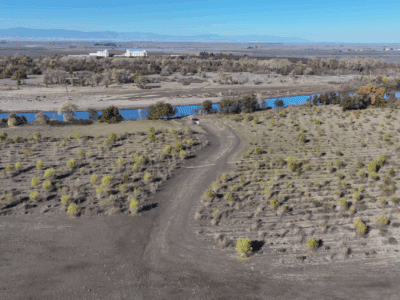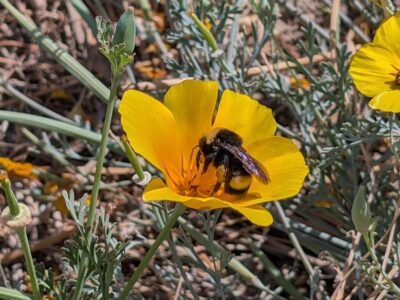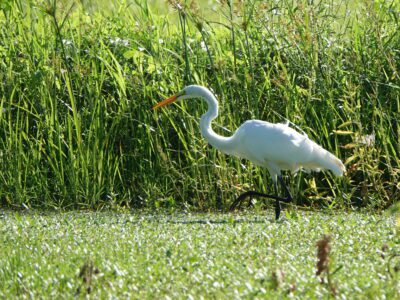- A collaborative effort led by River Partners in partnership with the Xerces Society, California Department of Fish and Wildlife, and Washington State University ushered in the largest coordinated monarch habitat restoration effort in the West.
- Starting in 2020, River Partners and our allies planted over 30,000 milkweed plants across 600 priority acres statewide, boosting critical habitat for endangered monarchs and other imperiled pollinators.
- Pollinator richness and abundance increased in restored areas and research revealed insights into best practices for expanding monarch and pollinator habitat.
Pollinators are essential heroes of our ecosystems.
However, the Western monarch butterfly, an iconic pollinator native to California and the West, faces significant challenges from habitat loss, pesticide exposure, and extreme weather exacerbated by climate change. In the 1980s, Western monarchs numbered approximately 4.5 million. Today, a meager 5% of their historic populations remain. Their current population is estimated at just over 233,000, according to the Xerces Society’s most recent count released in January.
With numbers down from 2022’s count of over 330,000 butterflies, Angela Laws, Endangered Species Conservation Biologist for the Xerces Society, said last year’s historic winter storms meant California entered the 2023 spring breeding season with fewer butterflies and with lower numbers over the summer, so it’s not surprising 2023’s overwintering population is down.
“It’s difficult to predict how conditions during any single year will influence the population,” she added.
Haley Mirts, a Restoration Science Ecologist at River Partners, agrees that weather can have variable consequences.
“Too little rain and you have smaller and fewer flowering plants. Too much rain can have the same effect, especially on plants with low-water tolerances,” she said. “The very wet winter made for historic bloom displays elsewhere in the state, so pollinators may have pivoted to drier areas to forage.”
After Western monarch populations crashed in 2020, a year in which only 2,000 butterflies were recorded, River Partners launched the West’s largest coordinated effort ever to recover populations in partnership with the California Department of Fish and Wildlife (CDFW), Xerces Society, and Washington State University. CDFW funded the effort through a $1.21 million grant.
As part of our first-of-its-kind effort, we planted over 30,000 milkweed plants as well as thousands of other pollinator-friendly plants across eight priority locations statewide (see map below). Now, four years of monitoring shows signs of hope, as monarchs and other imperiled pollinators are coming back to historic habitat they haven’t visited in decades.
“Pollinator richness and abundance increased at many of the sites over the course of the project, and were correlated with high availability of floral resources,” Mirts said. “By maintaining and planting more floral resources, these sites can continue to provide habitat for monarchs and other important pollinators.”

Riverside Recovery for Monarchs
In the arid west—especially in California’s Central Valley—monarchs are dependent on riparian landscapes. Monarchs migrate thousands of miles during their multi-generational journey from California’s coast to the Rocky Mountains and back. Three successive monarch generations make the migration from the coast to the mountains. The fourth generation of butterflies makes it all the way back to the coast in one long journey.
Evidence suggests that they follow the blooms of nectar-rich native plants and require access to water and shaded places to rest.
During their journey, all monarchs depend on milkweed to nurture and protect their young. Adults lay their eggs exclusively on milkweed plants, and the plants provide the caterpillars with the perfect source of nutrition as well as a unique strategy for self-defense. Milkweed contains cardenolides, toxic compounds that make the caterpillars unpalatable to many predators.
At the eight riverside sites River Partners restored, pollinator abundance and richness has increased over the past three years as plants took root and blossomed. Through regular monitoring, our alliance discovered the sites provided habitat for 21 species of imperiled butterflies, including monarchs, and even imperiled bees.
“Monarchs were observed at six of the eight sites and eggs and larvae found at four of those sites,” Mirts said. “Not only did the Project benefit the monarch butterfly, but it also created habitat for 31 butterfly species, 21 of which have been designated as declining or imperiled.”

Access to plants that bloom during different time periods is also critical to the monarch’s survival. Because their migration spans multiple years, monarchs may visit willow in the winter and early spring, for example, but may depend more on late-blooming goldenrod or western goldentop in the summer and fall. Early blooming species such as willow and coyote brush are particularly important for monarchs during their spring migration.
“The restoration efforts of the project are contributing to the overall conservation of these species,” Mirts said. “As the floral resources at the restoration projects mature, more species are likely to use the sites.”
Sustained Recovery for Monarchs with Restoration Partnerships
The success of our historic monarch initiative hinges on robust partnerships that are the heart of everything River Partners does. Working hand in hand with partners like CDFW, Xerces Society, and Washington State University, River Partners aims to continue establishing critical pollinator habitat throughout California to ensure the sustained recovery of not just monarchs, but numerous other threatened pollinator species.
Despite the sharp decline of monarchs in this decade, our restoration efforts offer a beacon of hope that we can revive monarch and pollinator habitat to support thriving ecosystems.
“Pollinators are so important to our economy and our well-being,” says Laws. “They’re important to agriculture, to natural ecosystems. Losing them would be devastating in so many ways. And one of the best ways we can protect these species is by respecting and restoring habitat.”








